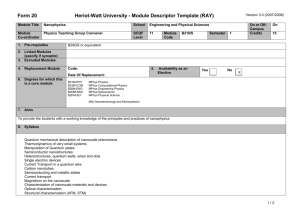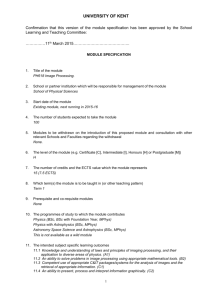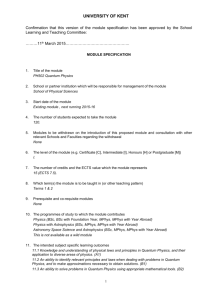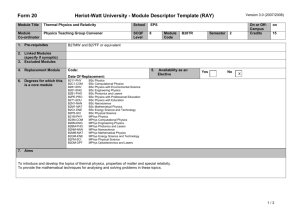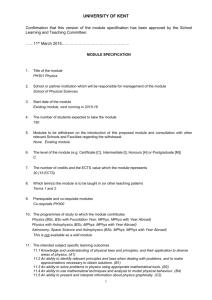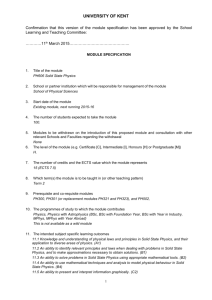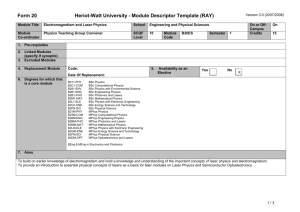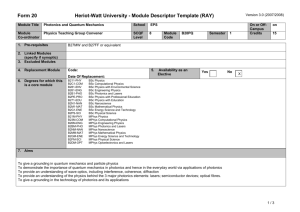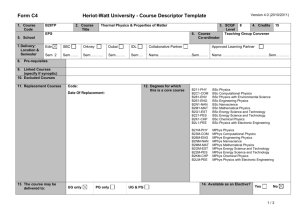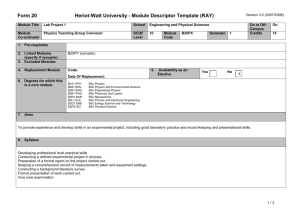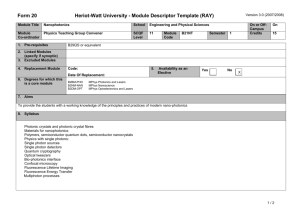B20QD1 Quantum Theory_Solid State v02 - Heriot
advertisement
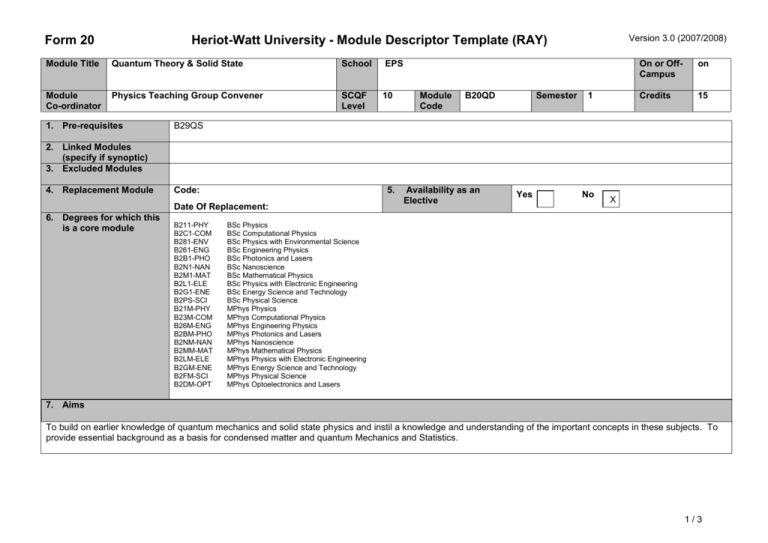
Form 20 Version 3.0 (2007/2008) Heriot-Watt University - Module Descriptor Template (RAY) Module Title Quantum Theory & Solid State School EPS Module Co-ordinator Physics Teaching Group Convener SCQF Level 10 1. Pre-requisites Module Code B20QD Semester 1 On or OffCampus on Credits 15 B29QS 2. Linked Modules (specify if synoptic) 3. Excluded Modules 4. Replacement Module Code: 5. Date Of Replacement: 6. Degrees for which this is a core module B211-PHY B2C1-COM B281-ENV B261-ENG B2B1-PHO B2N1-NAN B2M1-MAT B2L1-ELE B2G1-ENE B2PS-SCI B21M-PHY B23M-COM B26M-ENG B2BM-PHO B2NM-NAN B2MM-MAT B2LM-ELE B2GM-ENE B2FM-SCI B2DM-OPT Availability as an Elective Yes No X BSc Physics BSc Computational Physics BSc Physics with Environmental Science BSc Engineering Physics BSc Photonics and Lasers BSc Nanoscience BSc Mathematical Physics BSc Physics with Electronic Engineering BSc Energy Science and Technology BSc Physical Science MPhys Physics MPhys Computational Physics MPhys Engineering Physics MPhys Photonics and Lasers MPhys Nanoscience MPhys Mathematical Physics MPhys Physics with Electronic Engineering MPhys Energy Science and Technology MPhys Physical Science MPhys Optoelectronics and Lasers 7. Aims To build on earlier knowledge of quantum mechanics and solid state physics and instil a knowledge and understanding of the important concepts in these subjects. To provide essential background as a basis for condensed matter and quantum Mechanics and Statistics. 1/3 Form 20 Version 3.0 (2007/2008) Heriot-Watt University - Module Descriptor Template (RAY) Module Title Quantum Theory & Solid State School EPS Module Co-ordinator Physics Teaching Group Convener SCQF Level 10 Module Code B20QD Semester 1 On or OffCampus on Credits 15 8. Syllabus Quantum Theory: Operators and observables. Dirac’s notation for quantum states. Commutators and good quantum numbers. Schrodinger, Heisenberg and Interaction pictures. Angular momentum. Spin. The hydrogen atom. Solid State: Crystal structure, band structure, effective mass, donors and acceptors. Brillouin Zones. Doping & pn junctions . Fundamental optical absorption, exciton absorption, recombination processes, luminescence. Low Dimensional Structures. Multiple quantum wells and superlattices. Cyclotron resonance. Hall effect. Quantum Hall effect. Drude model for conductivity Phonons in solids – ball & spring model diatomic chains. Specific heat of solids. Superconductivity. 2/3 Form 20 Version 3.0 (2007/2008) Heriot-Watt University - Module Descriptor Template (RAY) Module Title Quantum Theory & Solid State School EPS Module Co-ordinator Physics Teaching Group Convener SCQF Level 10 Module Code B20QD Semester 1 On or OffCampus on Credits 15 9. Learning Outcomes (HWU Core Skills: Employability and Professional Career Readiness) Subject Mastery Understanding, Knowledge and Cognitive Skills Personal Abilities Scholarship, Enquiry and Research (Research-Informed Learning) Achieve a critical understanding of the principal theories of solid state physics. Achieve a critical understanding of quantum mechanics. Ability to analyse advanced problems in solid state physics and quantum mechanics. Apply the theories of solid state physics and quantum mechanics to problems or situations not previously encountered. Industrial, Commercial & Professional Practice Autonomy, Accountability & Working with Others Communication, Numeracy & ICT Personal abilities are embedded in the module. The module provides the opportunity to : Apply the advanced core knowledge expected of a professional physicist to gain professional level insights, Communicate effectively with professional level colleagues Interpret, use and evaluate critically a wide range of data to solve problems of both a familiar and unfamiliar nature Manage time effectively, work to deadlines and prioritise workloads Use a range of ICT skills with on-line materials and web links to support the learning process Apply strategies for appropriate selection of relevant information from a wide source and large body of knowledge Exercise significant initiative and independence in carrying out learning activities and researching information 10. Assessment Methods Method 11. Re-assessment Methods Duration of Exam Weighting (%) Synoptic modules? (if applicable) Examination 3 hours Method Duration of Exam (if applicable) 100% 12. Date and Version Date of Proposal 19/04/08 Date of Approval by School Committee Date of Implementation Version Number 2 3/3
